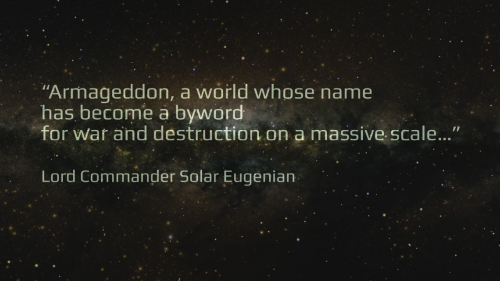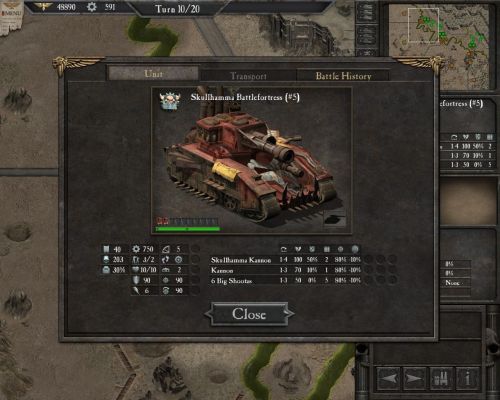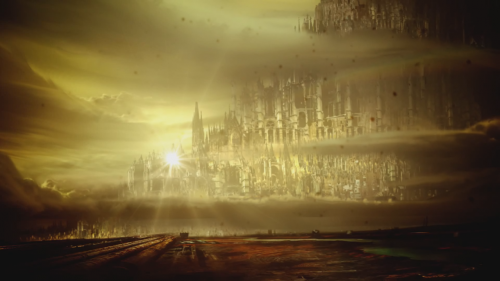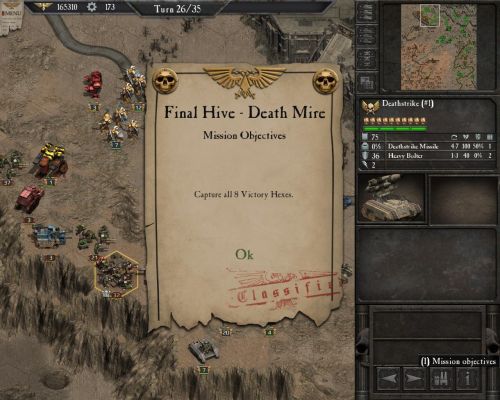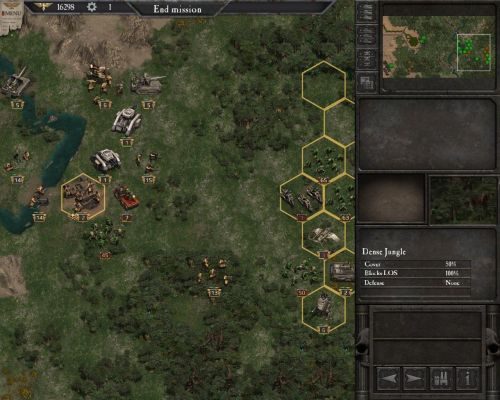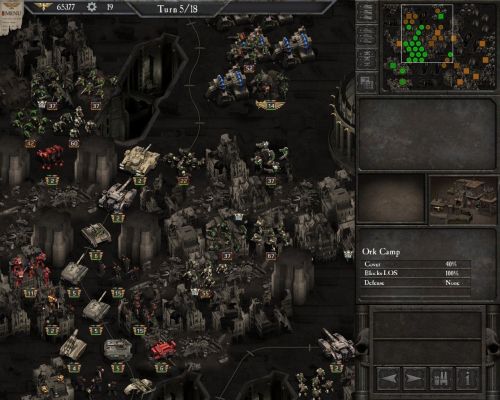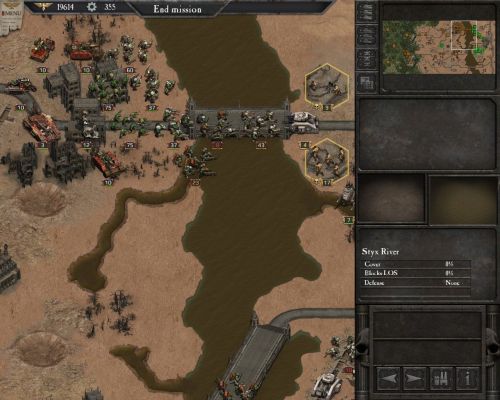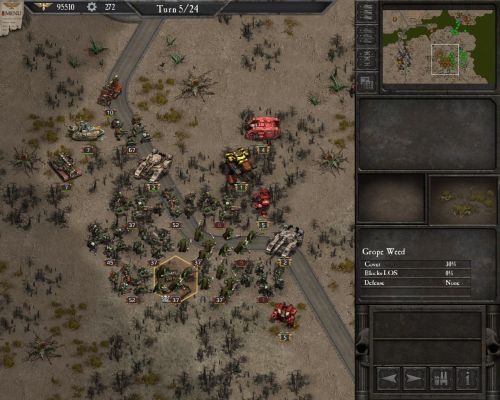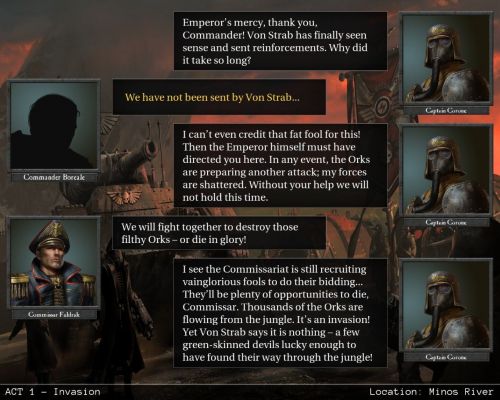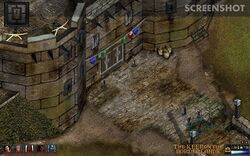TC Review: Warhammer 40k: Armageddon
TC Review: Warhammer 40k: Armageddon
Codex Review - posted by Whisky on Tue 10 February 2015, 16:24:17
Tags: Flashback Games; Slitherine; Warhammer 40,000: ArmageddonFaithful poster and contributor Darth Roxor got a chance to play Warhammer 40k: Armageddon. He was so moved by the content of it that he felt the need to write up a review.
At first glance, Armageddon looks like your typical Panzer General game. You have your hexes, your multitude of units in squads of various types and sizes, a top-down view on the strategic map, etc. But the game also brings some additions to the formula, and I honestly can’t say that any of them are very good.
Perhaps the biggest difference, which also influences a lot of further negative aspects of the game, is the lack of the soft/hard target distinction for units. Everything just has a single defensive value simply called “armour”, which is also why the overall damage model is different as well. To do any harm, an attacker’s weapon must cause more damage than the armour value of the defender – the damage roll has many factors to it, such as the cover level of the enemy, the line of sight obstruction provided by certain hexes, the unit’s inherent accuracy, the loss of accuracy per tile, the armour piercing value of the weapon and the amount of shots a unit fires when it attacks. There are a lot of somewhat vague variables at work here, and they lead to a ton of rather unnecessary randomness that can influence the attack roll in both ways and lead to hilariously unexpected results.
Perhaps the biggest difference, which also influences a lot of further negative aspects of the game, is the lack of the soft/hard target distinction for units. Everything just has a single defensive value simply called “armour”, which is also why the overall damage model is different as well. To do any harm, an attacker’s weapon must cause more damage than the armour value of the defender – the damage roll has many factors to it, such as the cover level of the enemy, the line of sight obstruction provided by certain hexes, the unit’s inherent accuracy, the loss of accuracy per tile, the armour piercing value of the weapon and the amount of shots a unit fires when it attacks. There are a lot of somewhat vague variables at work here, and they lead to a ton of rather unnecessary randomness that can influence the attack roll in both ways and lead to hilariously unexpected results.
Read the full article: TC Review: Warhammer 40k: Armageddon
[Review by Darth Roxor]
I used to play a lot of Panzer General back in the day, along with some of its offshoots like Fantasy General and Rites of War. What has boggled my mind for the last 15 or so years, though, is that no proper successor to the series has been released in that time. The basic formula of Panzer General is as simple as you can get – hexes, blitzin’, racing against the clock to get the best results and collecting new tin soldiers to send to the meatgrinder, just like you did when you were a kid.
Granted, there have been a bunch of ‘Generals’ and ‘Panzers’ released over the years, but, being the gullible chap that I am, I followed the common consensus and assumed they were just terrible without playing any of them to avoid being disgusted. However, last year brought upon something that I couldn’t possibly ignore.
That was Warhammer 40k: Armageddon. Set in that lovely grim darkness of the 41st millennium during one of its iconic conflicts, the Second War for Armageddon, the announcement of Armageddon immediately rekindled my memories of Rites of War. It was developed by Slitherine Strategies, who previously released another Panzer General clone titled Panzer Corps, so this time I gullibly assumed that it must have been at least good, since the devs decided to make another PG clone. And besides, how could it even be possible to screw up a game about mass-slaughtering ork hordes with the combined forces of the Imperium?
Someone called for an earthshaker?
At first glance, Armageddon looks like your typical Panzer General game. You have your hexes, your multitude of units in squads of various types and sizes, a top-down view on the strategic map, etc. But the game also brings some additions to the formula, and I honestly can’t say that any of them are very good.
Perhaps the biggest difference, which also influences a lot of further negative aspects of the game, is the lack of the soft/hard target distinction for units. Everything just has a single defensive value simply called “armour”, which is also why the overall damage model is different as well. To do any harm, an attacker’s weapon must cause more damage than the armour value of the defender – the damage roll has many factors to it, such as the cover level of the enemy, the line of sight obstruction provided by certain hexes, the unit’s inherent accuracy, the loss of accuracy per tile, the armour piercing value of the weapon and the amount of shots a unit fires when it attacks. There are a lot of somewhat vague variables at work here, and they lead to a ton of rather unnecessary randomness that can influence the attack roll in both ways and lead to hilariously unexpected results.
By far the biggest problem about the damage model, though, are all the weapon specifications. Suffice to say, the numbers are completely all over the place, and many of them are just bonkers. To mention a few examples:
- A normal bolter carried by tactical marines has more damage and armour penetration than heavy bolters, hurricane-pattern bolters mounted on land raider heavy tanks and mega-bolters mounted on titans.
- Ork choppas (aka big axes made of junk) have more armour penetration than dedicated anti-armour weapons such as lascannons and most artillery units.
- Ork shoota boyz (cannon fodder infantry) are better at fighting and surviving than warbosses, while legendary human units like the Blood Angels and Salamanders chapter masters are worse than upgraded tactical marines.
And those are just a few examples, but they lead to all sorts of highly interesting situations, such as your Leman Russ Annihilator main battle tank not managing to do any damage to a grot light tank, and subsequently getting taken apart by a horde of angry goblins armed with choppas. I bet the Chinese army is already taking notes.
The second big change is how the game handles casualties. The losses a squad takes are no longer divided into wounds/kills, instead each unit has a ‘hp’ value tied to its overall squad size, meant to represent the status of a singular squad member – if the hp goes to 0, the squad suffers 1 kill. So for example, a tank has 3 hp and squad size 5 – taking 10 damage will reduce it to 2/3 hp and squad size 2.
Arguably, it is not that bad of a change when it comes to units with more hp than squad size, but it has the very bad side effect of making almost all infantry a complete liability. It was perhaps silly in previous Panzer General games when you could ‘rest’ a battered infantry squad from 3 units to 13 in a single turn, but the alternative that Armageddon proposes is no better. When your Imperial Guard units have only 1 hp, their just about only purposes are to entrench as a bait and soak up damage (because the AI will usually identify infantry as an easy target), capture victory hexes or finish off stragglers. Even Space Marines aren’t spared this fate because their hp is 2, although at least later in the game you get the Sanguinary Guard that are excellent at tearing apart tanks and light infantry in quick assaults. But the moment they get attacked back, they are boned.
The way the game resolves melee damage also makes dedicated melee infantry much more squishy than its shooty counterparts, even though most of those units are supposed to be tough assault squads, like Terminators. The melee attack phase comes always only after the ranged phase, which means your melee dudes will effectively never strike at full strength. The AI can afford sending suicidal shock troops at its enemies, but the same definitely can’t be said for the player.
The worst part of the unit health model, however, is how the game handles reinforcements, but I’ll explain that in the next chapter.
Another addition to unit profiles is the morale value - every unit starts with 100 morale that goes down each time it attacks or gets attacked. Replenishing morale is done either by resting or standing next to a Commander unit that will pat the combatants on the back saying ‘good job’ each turn. The lower the morale, the lower the fighting capabilities of the unit.
This is the most peculiar part about the whole system – it’s supposed to simulate not just ‘morale’ but also ‘battle readiness’. Okay, then how does that work for those commanders? Do they keep carrying around gas and ammunition for the tanks as well? And finally, it can lead to some downright absurd situations like when your artillery is placed 6 hexes away from the fighting, it keeps shelling the enemy all the time for massive losses while taking none itself, and yet its morale just keeps dropping. Are those crewmen all pacifists or what?
The last ‘big’ change that needs to be mentioned is that Armageddon gives units much bigger weapon ranges. In most Panzer General style games, range was usually around 1-3 hexes. Here, however, depending on the weapon used, it can go even up to 7. It’s an interesting change because it gives you some better degree of tactical placement for your troops, but the sad truth is that, given how the campaign is structured and taking into consideration the mentioned previously weirdness of all weapon stats, the general rule is that you should get as much range as possible on all units. Melta cannons do insane damage to armour, but what use are they with their range 2? Most of the melta units have terrible initiative, and they will get slaughtered by everything the enemy has before they can even fire. The same is true for most flying units, which are very squishy by nature, but are often armed with low-range weapons.
Glory for the first man to die
The game’s campaign takes place during the Second War for Armageddon when the ork Waaagh of warboss Ghazghkull Thraka stormed the planet by surprise. The campaign is divided into three chapters that reflect the three phases of the conflict – the initial invasion, when only the Imperial Guardsmen of the Armageddon Steel Legion were desperately trying to fight the orks back; the Imperial counteroffensive with the arrival of the Blood Angels, Ultramarines and Salamanders space marines; and finally the clean up where the Imperium successfully liberates Armageddon by kicking the Waaagh back whence it came.
The game introduces all the iconic characters of the war, such as Commissar Yarrick, Commander Dante and the incompetent governor Herman von Strab, but all of them are basically just talking heads during briefings. Sometimes they appear as units on certain maps, but their combat capabilities are far from adequate, and they are best left in the back to hug the artillerymen.
Fluff aside, in practical terms the campaign has its ups and downs, and it would have been okay if not for a couple of key issues. Overall, it has a total of 30 missions that will take you some 30 hours to play through, it has a variety of general objectives, from escort missions, through siege breakers to assassinations, and a handful of its missions are pretty memorable and challenging. Sometimes (but not that often) your goals will change mid-way, and, for example, you will have to ditch a line of entrenchments you were protecting and race to the other side of the map.
Each mission is preceded by a briefing with static character avatars. Sometimes you can also choose dialogue options, but it’s disappointing that they do not influence anything. The dialogue choices always present you two options: ‘good citizen’ and ‘EXTRA HERETIC!’. At first I thought they would influence some things like starting army morale or funding or just about anything, but they are only there for flavour. Constantly picking the ‘bad’ options doesn’t even lead to you getting executed by an inquisitor at the end. Meh.
There are only two instances where the options actually matter, and those are when you are asked to pick a place to strike. The first time it changes the next two missions you will play, the second time it changes only one. Not a whole lot of non-linearity.
Once the briefing is done, you can finally put your boots on the ground and deploy your forces to smash some orks. This is obviously the meat of the game, and it is just a shame that nearly every gameplay element here is flawed despite being easy to fix.
For starters, I mentioned that the ‘macro’ mission themes are rather varied, but the same unfortunately cannot be said about the micro mission structures. Sure, the missions may be about liberating hive cities, breaking through ork sieges, etc, but in gameplay terms, it mostly translates to “grab x victory hexes before time runs out”. There are a few missions that are extremely fun because they need you to be constantly on the move to protect objectives that appear on the map as the turns go by, but they are just too few in-between generic hex capping. In fact, the missions get so repetitive in the long run that after a while you’ll be getting deja vu each time you land on a map that has a large plain to the south, a river with 3-4 bridges in the middle and a hive city border to the north + a “capture 5 victory hexes” objective.
Another bad aspect of the above is that there is nothing on those maps to break the tedium of sieging victory hexes. There are no side objectives, no degrees of failure/victory, no optional sites to liberate for cash or new units, nothing. Just deploy, plow through ork hordes, cap a bunch of hexes, win. Even though there are non-critical locations that can be capped, but they give you nothing more than Glory, which is just a differently named highscore.
The visual setup of the maps also contributes to the lack of variety. The vast majority of the game takes place on Armageddon’s wastelands and hive city borders, with lines of entrenchments and ruined buildings being the only landmarks. But the planet also has vast jungles, which are used in maybe 3 or 4 missions at best. There is also only one mission inside an actual hive city, which is completely different from the rest of the game because it forces you to rely mostly on infantry. Only one mission will let you use a monorail for quick troop movement, too. Everything else just boils down to crossing rivers and shelling ruined factories on dunes.
And shelling factories is what you’ll be doing the most because we now arrive at the game’s biggest flaw. The AI, or lack thereof. From my observations, the enemy units have no actual ‘routines’. They never patrol the map on a hunter-killer basis, they never try to do something unexpected – everything is just scripted to hell. Most of the enemy units are scripted to sit tight and never move an inch unless the player moves into their spotting range. Sometimes they are scripted to activate and rush towards a location once you capture a hex. Others are scripted to just rush towards your starting location at the beginning. But they never, ever, do anything clever on their own.
Needless to say, this leads to a whole lot of silly situations, is ripe for exploits and, unfortunately, completely defines the gameplay of Armageddon. Since the orks won’t move even if they are under attack unless they spot something, and since their spotting ranges are usually terrible, your best bet is to just get a visual on an ork horde with a scout and then shell it to kingdom come with your 3+ range units. Often, this is actually the only sane course of action, as well, because the moment the orks spot you, their entire horde will activate and start tearing your vanguard to shreds with all its tanks that have been conveniently placed beyond the range you could safely scout.
The overreliance on scripting also has some other repercussions. For instance, an ork unit can stand 2 hexes away from a mission-critical hex and it won’t be trying to recapture it. It’ll just keep standing on its cozy cover and wait for the mission to end. On many maps you will also stumble upon static enemy units being placed seemingly at random, in locations far away from the ‘main’ course of action – whether these activate upon reaching one specific hex somewhere or if they just have broken scripts to begin with is a mystery.
As for the general campaign difficulty, this is a very mixed bag, but it is also related to the AI problems. The first chapter, the invasion, is the toughest and the coolest phase of the game. You only have Imperial Guard units at your disposal and no access to superheavy tanks or titans. It has the largest amount of missions focused on desperate defences (the last mission comes to mind in particular), switching trench lines, rescuing auxiliary units, etc - some of the maps here can get really intense. This chapter is also the least static because the orks don’t have access to heavy armaments yet as well, which means you don’t get bogged down with the shelling of hp-bloated mega nobz and looted baneblades.
Unfortunately, a lot of that changes in chapter 2, and pretty much completely vanishes in chapter 3. This is because in chapters 2 and 3 you get access to superheavy tanks and titans, which are cheese incarnate. The gist of it is that the AI is scared shitless of attacking them, and will never do so except for situations when it has very powerful anti-tank units at its disposal, or when your superheavies are very low on health. Both of these situations are rare, and the practical meaning of it is that you can drive a Baneblade into the entire ork horde and bodyblock it off completely from reaching your other forces. Bonus points if you can block the orks off with a chokepoint like a bridge. The tank/titan will be completely safe even when surrounded by 4 tankbusta rocketeer squads or various medium-heavy tanks.
I promised to talk about reinforcements earlier, and I guess this is the best time to do it.
Since the kills/injuries distinction has been done away with, you can probably guess that your units will be taking many more losses than usual. If you want to reinforce a unit during a mission, you’ll have to pay up, and the reinforced unit will also lose a portion of its xp. This is reasonable.
What is however less reasonable is that you also have to pay up for the replacements when transitioning between maps, and there is no difference between paying for replacements during the mission and after it. Suffice to say, the money management in Armageddon is really, really weird and ridiculously opaque. You don’t even get a single table post-mission telling you how much requisition you got and how much of it was spent on replacements. Very often you will get less money than you need to spend (even if your losses were negligible!), and you have no agency in picking priorities for reinforcements, which means the game might just as well pick your cannon fodder Steel Legion conscripts over reinforcing a tank.
Along with the terrible AI, I find the replacement system to be the worst flaw of the game. It discourages you from making risky plays and quick blitzes and just funnels you into one specific playstyle – shell everything from afar and get the least casualties possible or you’ll be getting so much casualties you won’t be able to pay them back. And from that, there are only a few steps towards a death spiral resulting from a budget deficit.
The last thing that needs to be mentioned before closing this chapter is the unit selection. It is, once again, as always, a mixed bag. On one hand, the unit rosters for both the Imperium and the Orks are very impressive. Every unit category is full of various vehicles and infantry squads of which you may or may not have heard, and most of them are also further diversified into different patterns or upgraded versions. Deciding what units to take to your little army is simply very fun, and, as far as I can tell, all the unit icons are based on tabletop miniatures and are thus pretty well-detailed.
A few issues arise, however, in how the units are unlocked over time and when you look at some of their stats.
As with all the other numbers in Armageddon, these are all over the place. Some Terminators have 2 hp while others have 3, a Land Speeder Storm doesn’t differ at all from a Typhoon except that it doesn’t have a rocket launcher, yet its cost is the same, etc.
One also has to question the usefulness of the three Space Marine chapters. The Blood Angels are clearly the most superior option, as they have the best combat stats. The Salamanders have universally worse accuracy but just slightly more armour. The Ultramarines only have worse accuracy but are slightly cheaper. Practically speaking, there is absolutely no reason to take any of the other chapters over the Blood Angels, especially since their differences in available units are also minor at best.
Some of the units you unlock during the course of the game will also make you question the designers’ judgement. There are many instances where objectively worse units will be made available a long time after their better counterparts (IG gunships come to mind). At one point you will also unlock upgraded versions of superheavy tanks, out of which a Shadowsword with a weapon upgrade is very clearly the best thing to get among all the others, except maybe the upgraded Baneblade. You also have to wonder what exactly is the practical use of all the anti-air units you can get when the orks have only 1 aerial unit, the deffkopta, which, to make matters even worse, appears only in singular missions.
I hear the machine spirit’s voice
There isn’t all that much to talk about when it comes to the technical side of the game. The visuals simply work, although I’m sure I’d be more appreciative of the game’s graphics if it didn’t throw all those dunes at me all the time. As mentioned before, the units are detailed and they are shown on the map as static pieces with no animation.
Soundtrack is very minimalistic and almost non-existent. I don’t think there are more than three tunes in the jukebox. For sounds I can’t really say anything more than ‘weapons make pew pews, dakka dakka and explosions’ because that’s really all there is to it.
The briefings are all composed of static talking heads on concept art pieces. The voice acting is cheesy and B-quality as hell, and the same can be said about the writing. There are also some typos here and there, nothing to write home about.
The game is very stable and reasonably bug-free – I had no crashes while playing, and the only bugs I encountered were some fog of war and graphics glitches that were probably caused by furious savescumming. Very rarely I’d also get attacked by melee enemies from across 3 hexes or my units would refuse to counterattack (literally singular occasions, but they are there). Sometimes the objectives also don’t work like they should, and you might find yourself winning a mission where you have to place 5 units on 5 hexes with just 1 unit on a single hex. I also have to commend the game on taking only slightly above 1GB of disk space.
Finally, Armageddon has 5 difficulty settings, ranging from Easy to Very Hard. I played through the game on Challenging (3rd) and Very Hard (5th), and I honestly have only one piece of advice if you want to play this – don’t, under any circumstances, ever go beyond Challenging. All the difficulty settings do is increase the volume of enemy squads - they don’t add any new AI functions or objectives or whatever. Easy is way too, well, easy, and as far as I can tell there is no difference between Normal and Challenging, which is rather strange. Hard, on the other hand, increases all enemy squad sizes from Normal/Challenging by 20%. Very Hard boosts the Hard squads by another 25%! This leads to such incredibly obnoxious health bloat that it almost makes the game unplayable. It doesn’t increase the ‘difficulty’ per se in any way – all it does is prolong the artillery shelling and thus add more tedium to the game.
What manner of heresy is this?
I got Armageddon expecting another Rites of War. Unfortunately, it was nowhere near as fun. It has a few precious moments where it really shines, but most of its gameplay is held back by the terrible AI, the campaign repetitiveness and the tedium that is enforced by its lacklustre mechanics. The Panzer General formula is simple and to the point for a reason. Slitherine tried to reinvent the wheel and simply failed.
The only way I can possibly recommend Armageddon is if you are both starved for a Panzer General clone and are a fan of the Warhammer 40k setting with a desire to pew-pew some orks withflashlights lasguns. But even so, waiting for a major sale is very advised – the game currently costs 37 euro on Steam, and that is, quite simply, a goddamn rip-off.
I used to play a lot of Panzer General back in the day, along with some of its offshoots like Fantasy General and Rites of War. What has boggled my mind for the last 15 or so years, though, is that no proper successor to the series has been released in that time. The basic formula of Panzer General is as simple as you can get – hexes, blitzin’, racing against the clock to get the best results and collecting new tin soldiers to send to the meatgrinder, just like you did when you were a kid.
Granted, there have been a bunch of ‘Generals’ and ‘Panzers’ released over the years, but, being the gullible chap that I am, I followed the common consensus and assumed they were just terrible without playing any of them to avoid being disgusted. However, last year brought upon something that I couldn’t possibly ignore.
That was Warhammer 40k: Armageddon. Set in that lovely grim darkness of the 41st millennium during one of its iconic conflicts, the Second War for Armageddon, the announcement of Armageddon immediately rekindled my memories of Rites of War. It was developed by Slitherine Strategies, who previously released another Panzer General clone titled Panzer Corps, so this time I gullibly assumed that it must have been at least good, since the devs decided to make another PG clone. And besides, how could it even be possible to screw up a game about mass-slaughtering ork hordes with the combined forces of the Imperium?
Someone called for an earthshaker?
At first glance, Armageddon looks like your typical Panzer General game. You have your hexes, your multitude of units in squads of various types and sizes, a top-down view on the strategic map, etc. But the game also brings some additions to the formula, and I honestly can’t say that any of them are very good.
Perhaps the biggest difference, which also influences a lot of further negative aspects of the game, is the lack of the soft/hard target distinction for units. Everything just has a single defensive value simply called “armour”, which is also why the overall damage model is different as well. To do any harm, an attacker’s weapon must cause more damage than the armour value of the defender – the damage roll has many factors to it, such as the cover level of the enemy, the line of sight obstruction provided by certain hexes, the unit’s inherent accuracy, the loss of accuracy per tile, the armour piercing value of the weapon and the amount of shots a unit fires when it attacks. There are a lot of somewhat vague variables at work here, and they lead to a ton of rather unnecessary randomness that can influence the attack roll in both ways and lead to hilariously unexpected results.
By far the biggest problem about the damage model, though, are all the weapon specifications. Suffice to say, the numbers are completely all over the place, and many of them are just bonkers. To mention a few examples:
- A normal bolter carried by tactical marines has more damage and armour penetration than heavy bolters, hurricane-pattern bolters mounted on land raider heavy tanks and mega-bolters mounted on titans.
- Ork choppas (aka big axes made of junk) have more armour penetration than dedicated anti-armour weapons such as lascannons and most artillery units.
- Ork shoota boyz (cannon fodder infantry) are better at fighting and surviving than warbosses, while legendary human units like the Blood Angels and Salamanders chapter masters are worse than upgraded tactical marines.
And those are just a few examples, but they lead to all sorts of highly interesting situations, such as your Leman Russ Annihilator main battle tank not managing to do any damage to a grot light tank, and subsequently getting taken apart by a horde of angry goblins armed with choppas. I bet the Chinese army is already taking notes.
The second big change is how the game handles casualties. The losses a squad takes are no longer divided into wounds/kills, instead each unit has a ‘hp’ value tied to its overall squad size, meant to represent the status of a singular squad member – if the hp goes to 0, the squad suffers 1 kill. So for example, a tank has 3 hp and squad size 5 – taking 10 damage will reduce it to 2/3 hp and squad size 2.
Arguably, it is not that bad of a change when it comes to units with more hp than squad size, but it has the very bad side effect of making almost all infantry a complete liability. It was perhaps silly in previous Panzer General games when you could ‘rest’ a battered infantry squad from 3 units to 13 in a single turn, but the alternative that Armageddon proposes is no better. When your Imperial Guard units have only 1 hp, their just about only purposes are to entrench as a bait and soak up damage (because the AI will usually identify infantry as an easy target), capture victory hexes or finish off stragglers. Even Space Marines aren’t spared this fate because their hp is 2, although at least later in the game you get the Sanguinary Guard that are excellent at tearing apart tanks and light infantry in quick assaults. But the moment they get attacked back, they are boned.
The way the game resolves melee damage also makes dedicated melee infantry much more squishy than its shooty counterparts, even though most of those units are supposed to be tough assault squads, like Terminators. The melee attack phase comes always only after the ranged phase, which means your melee dudes will effectively never strike at full strength. The AI can afford sending suicidal shock troops at its enemies, but the same definitely can’t be said for the player.
The worst part of the unit health model, however, is how the game handles reinforcements, but I’ll explain that in the next chapter.
Another addition to unit profiles is the morale value - every unit starts with 100 morale that goes down each time it attacks or gets attacked. Replenishing morale is done either by resting or standing next to a Commander unit that will pat the combatants on the back saying ‘good job’ each turn. The lower the morale, the lower the fighting capabilities of the unit.
This is the most peculiar part about the whole system – it’s supposed to simulate not just ‘morale’ but also ‘battle readiness’. Okay, then how does that work for those commanders? Do they keep carrying around gas and ammunition for the tanks as well? And finally, it can lead to some downright absurd situations like when your artillery is placed 6 hexes away from the fighting, it keeps shelling the enemy all the time for massive losses while taking none itself, and yet its morale just keeps dropping. Are those crewmen all pacifists or what?
The last ‘big’ change that needs to be mentioned is that Armageddon gives units much bigger weapon ranges. In most Panzer General style games, range was usually around 1-3 hexes. Here, however, depending on the weapon used, it can go even up to 7. It’s an interesting change because it gives you some better degree of tactical placement for your troops, but the sad truth is that, given how the campaign is structured and taking into consideration the mentioned previously weirdness of all weapon stats, the general rule is that you should get as much range as possible on all units. Melta cannons do insane damage to armour, but what use are they with their range 2? Most of the melta units have terrible initiative, and they will get slaughtered by everything the enemy has before they can even fire. The same is true for most flying units, which are very squishy by nature, but are often armed with low-range weapons.
Glory for the first man to die
The game’s campaign takes place during the Second War for Armageddon when the ork Waaagh of warboss Ghazghkull Thraka stormed the planet by surprise. The campaign is divided into three chapters that reflect the three phases of the conflict – the initial invasion, when only the Imperial Guardsmen of the Armageddon Steel Legion were desperately trying to fight the orks back; the Imperial counteroffensive with the arrival of the Blood Angels, Ultramarines and Salamanders space marines; and finally the clean up where the Imperium successfully liberates Armageddon by kicking the Waaagh back whence it came.
The game introduces all the iconic characters of the war, such as Commissar Yarrick, Commander Dante and the incompetent governor Herman von Strab, but all of them are basically just talking heads during briefings. Sometimes they appear as units on certain maps, but their combat capabilities are far from adequate, and they are best left in the back to hug the artillerymen.
Fluff aside, in practical terms the campaign has its ups and downs, and it would have been okay if not for a couple of key issues. Overall, it has a total of 30 missions that will take you some 30 hours to play through, it has a variety of general objectives, from escort missions, through siege breakers to assassinations, and a handful of its missions are pretty memorable and challenging. Sometimes (but not that often) your goals will change mid-way, and, for example, you will have to ditch a line of entrenchments you were protecting and race to the other side of the map.
Each mission is preceded by a briefing with static character avatars. Sometimes you can also choose dialogue options, but it’s disappointing that they do not influence anything. The dialogue choices always present you two options: ‘good citizen’ and ‘EXTRA HERETIC!’. At first I thought they would influence some things like starting army morale or funding or just about anything, but they are only there for flavour. Constantly picking the ‘bad’ options doesn’t even lead to you getting executed by an inquisitor at the end. Meh.
There are only two instances where the options actually matter, and those are when you are asked to pick a place to strike. The first time it changes the next two missions you will play, the second time it changes only one. Not a whole lot of non-linearity.
Once the briefing is done, you can finally put your boots on the ground and deploy your forces to smash some orks. This is obviously the meat of the game, and it is just a shame that nearly every gameplay element here is flawed despite being easy to fix.
For starters, I mentioned that the ‘macro’ mission themes are rather varied, but the same unfortunately cannot be said about the micro mission structures. Sure, the missions may be about liberating hive cities, breaking through ork sieges, etc, but in gameplay terms, it mostly translates to “grab x victory hexes before time runs out”. There are a few missions that are extremely fun because they need you to be constantly on the move to protect objectives that appear on the map as the turns go by, but they are just too few in-between generic hex capping. In fact, the missions get so repetitive in the long run that after a while you’ll be getting deja vu each time you land on a map that has a large plain to the south, a river with 3-4 bridges in the middle and a hive city border to the north + a “capture 5 victory hexes” objective.
Another bad aspect of the above is that there is nothing on those maps to break the tedium of sieging victory hexes. There are no side objectives, no degrees of failure/victory, no optional sites to liberate for cash or new units, nothing. Just deploy, plow through ork hordes, cap a bunch of hexes, win. Even though there are non-critical locations that can be capped, but they give you nothing more than Glory, which is just a differently named highscore.
The visual setup of the maps also contributes to the lack of variety. The vast majority of the game takes place on Armageddon’s wastelands and hive city borders, with lines of entrenchments and ruined buildings being the only landmarks. But the planet also has vast jungles, which are used in maybe 3 or 4 missions at best. There is also only one mission inside an actual hive city, which is completely different from the rest of the game because it forces you to rely mostly on infantry. Only one mission will let you use a monorail for quick troop movement, too. Everything else just boils down to crossing rivers and shelling ruined factories on dunes.
And shelling factories is what you’ll be doing the most because we now arrive at the game’s biggest flaw. The AI, or lack thereof. From my observations, the enemy units have no actual ‘routines’. They never patrol the map on a hunter-killer basis, they never try to do something unexpected – everything is just scripted to hell. Most of the enemy units are scripted to sit tight and never move an inch unless the player moves into their spotting range. Sometimes they are scripted to activate and rush towards a location once you capture a hex. Others are scripted to just rush towards your starting location at the beginning. But they never, ever, do anything clever on their own.
Needless to say, this leads to a whole lot of silly situations, is ripe for exploits and, unfortunately, completely defines the gameplay of Armageddon. Since the orks won’t move even if they are under attack unless they spot something, and since their spotting ranges are usually terrible, your best bet is to just get a visual on an ork horde with a scout and then shell it to kingdom come with your 3+ range units. Often, this is actually the only sane course of action, as well, because the moment the orks spot you, their entire horde will activate and start tearing your vanguard to shreds with all its tanks that have been conveniently placed beyond the range you could safely scout.
The overreliance on scripting also has some other repercussions. For instance, an ork unit can stand 2 hexes away from a mission-critical hex and it won’t be trying to recapture it. It’ll just keep standing on its cozy cover and wait for the mission to end. On many maps you will also stumble upon static enemy units being placed seemingly at random, in locations far away from the ‘main’ course of action – whether these activate upon reaching one specific hex somewhere or if they just have broken scripts to begin with is a mystery.
As for the general campaign difficulty, this is a very mixed bag, but it is also related to the AI problems. The first chapter, the invasion, is the toughest and the coolest phase of the game. You only have Imperial Guard units at your disposal and no access to superheavy tanks or titans. It has the largest amount of missions focused on desperate defences (the last mission comes to mind in particular), switching trench lines, rescuing auxiliary units, etc - some of the maps here can get really intense. This chapter is also the least static because the orks don’t have access to heavy armaments yet as well, which means you don’t get bogged down with the shelling of hp-bloated mega nobz and looted baneblades.
Unfortunately, a lot of that changes in chapter 2, and pretty much completely vanishes in chapter 3. This is because in chapters 2 and 3 you get access to superheavy tanks and titans, which are cheese incarnate. The gist of it is that the AI is scared shitless of attacking them, and will never do so except for situations when it has very powerful anti-tank units at its disposal, or when your superheavies are very low on health. Both of these situations are rare, and the practical meaning of it is that you can drive a Baneblade into the entire ork horde and bodyblock it off completely from reaching your other forces. Bonus points if you can block the orks off with a chokepoint like a bridge. The tank/titan will be completely safe even when surrounded by 4 tankbusta rocketeer squads or various medium-heavy tanks.
I promised to talk about reinforcements earlier, and I guess this is the best time to do it.
Since the kills/injuries distinction has been done away with, you can probably guess that your units will be taking many more losses than usual. If you want to reinforce a unit during a mission, you’ll have to pay up, and the reinforced unit will also lose a portion of its xp. This is reasonable.
What is however less reasonable is that you also have to pay up for the replacements when transitioning between maps, and there is no difference between paying for replacements during the mission and after it. Suffice to say, the money management in Armageddon is really, really weird and ridiculously opaque. You don’t even get a single table post-mission telling you how much requisition you got and how much of it was spent on replacements. Very often you will get less money than you need to spend (even if your losses were negligible!), and you have no agency in picking priorities for reinforcements, which means the game might just as well pick your cannon fodder Steel Legion conscripts over reinforcing a tank.
Along with the terrible AI, I find the replacement system to be the worst flaw of the game. It discourages you from making risky plays and quick blitzes and just funnels you into one specific playstyle – shell everything from afar and get the least casualties possible or you’ll be getting so much casualties you won’t be able to pay them back. And from that, there are only a few steps towards a death spiral resulting from a budget deficit.
The last thing that needs to be mentioned before closing this chapter is the unit selection. It is, once again, as always, a mixed bag. On one hand, the unit rosters for both the Imperium and the Orks are very impressive. Every unit category is full of various vehicles and infantry squads of which you may or may not have heard, and most of them are also further diversified into different patterns or upgraded versions. Deciding what units to take to your little army is simply very fun, and, as far as I can tell, all the unit icons are based on tabletop miniatures and are thus pretty well-detailed.
A few issues arise, however, in how the units are unlocked over time and when you look at some of their stats.
As with all the other numbers in Armageddon, these are all over the place. Some Terminators have 2 hp while others have 3, a Land Speeder Storm doesn’t differ at all from a Typhoon except that it doesn’t have a rocket launcher, yet its cost is the same, etc.
One also has to question the usefulness of the three Space Marine chapters. The Blood Angels are clearly the most superior option, as they have the best combat stats. The Salamanders have universally worse accuracy but just slightly more armour. The Ultramarines only have worse accuracy but are slightly cheaper. Practically speaking, there is absolutely no reason to take any of the other chapters over the Blood Angels, especially since their differences in available units are also minor at best.
Some of the units you unlock during the course of the game will also make you question the designers’ judgement. There are many instances where objectively worse units will be made available a long time after their better counterparts (IG gunships come to mind). At one point you will also unlock upgraded versions of superheavy tanks, out of which a Shadowsword with a weapon upgrade is very clearly the best thing to get among all the others, except maybe the upgraded Baneblade. You also have to wonder what exactly is the practical use of all the anti-air units you can get when the orks have only 1 aerial unit, the deffkopta, which, to make matters even worse, appears only in singular missions.
I hear the machine spirit’s voice
There isn’t all that much to talk about when it comes to the technical side of the game. The visuals simply work, although I’m sure I’d be more appreciative of the game’s graphics if it didn’t throw all those dunes at me all the time. As mentioned before, the units are detailed and they are shown on the map as static pieces with no animation.
Soundtrack is very minimalistic and almost non-existent. I don’t think there are more than three tunes in the jukebox. For sounds I can’t really say anything more than ‘weapons make pew pews, dakka dakka and explosions’ because that’s really all there is to it.
The briefings are all composed of static talking heads on concept art pieces. The voice acting is cheesy and B-quality as hell, and the same can be said about the writing. There are also some typos here and there, nothing to write home about.
The game is very stable and reasonably bug-free – I had no crashes while playing, and the only bugs I encountered were some fog of war and graphics glitches that were probably caused by furious savescumming. Very rarely I’d also get attacked by melee enemies from across 3 hexes or my units would refuse to counterattack (literally singular occasions, but they are there). Sometimes the objectives also don’t work like they should, and you might find yourself winning a mission where you have to place 5 units on 5 hexes with just 1 unit on a single hex. I also have to commend the game on taking only slightly above 1GB of disk space.
Finally, Armageddon has 5 difficulty settings, ranging from Easy to Very Hard. I played through the game on Challenging (3rd) and Very Hard (5th), and I honestly have only one piece of advice if you want to play this – don’t, under any circumstances, ever go beyond Challenging. All the difficulty settings do is increase the volume of enemy squads - they don’t add any new AI functions or objectives or whatever. Easy is way too, well, easy, and as far as I can tell there is no difference between Normal and Challenging, which is rather strange. Hard, on the other hand, increases all enemy squad sizes from Normal/Challenging by 20%. Very Hard boosts the Hard squads by another 25%! This leads to such incredibly obnoxious health bloat that it almost makes the game unplayable. It doesn’t increase the ‘difficulty’ per se in any way – all it does is prolong the artillery shelling and thus add more tedium to the game.
What manner of heresy is this?
I got Armageddon expecting another Rites of War. Unfortunately, it was nowhere near as fun. It has a few precious moments where it really shines, but most of its gameplay is held back by the terrible AI, the campaign repetitiveness and the tedium that is enforced by its lacklustre mechanics. The Panzer General formula is simple and to the point for a reason. Slitherine tried to reinvent the wheel and simply failed.
The only way I can possibly recommend Armageddon is if you are both starved for a Panzer General clone and are a fan of the Warhammer 40k setting with a desire to pew-pew some orks with
There are 11 comments on TC Review: Warhammer 40k: Armageddon





